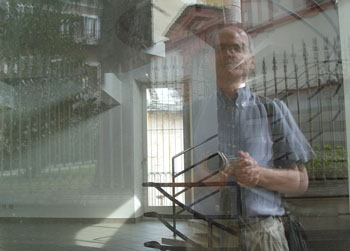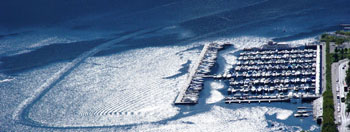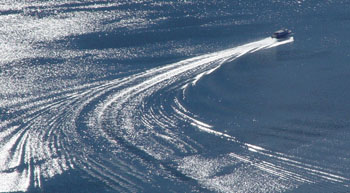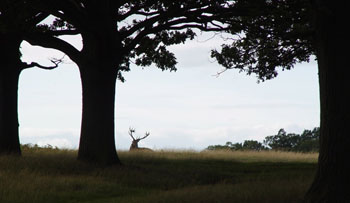Thursday, September 30, 2004
RAMPARTS, IRAQ AND TWO GAVINS
The book I arrived in Orselina reading was Gavin Maxwell’s astounding A Reed Shaken by the Wind, recounting his travels among the Marsh Arabs of southern Iraq with Wilfred Thesiger. The book is so beautiful I often found myself reading out whole pages to Elaine. But the nature of these people is not romanticised: they are pretty savage at times, indeed Maxwell on one occasion notes that attempts by the central government to be liberal backfired badly.
Maxwell also credits Gavin Young, the other Englishman linked with Thesiger’s time on the Marshes, noting that he “first towered on my horizon as a namesake against whom the Arabs measured me to my discredit, as a man who could shave with three strokes of a razor and had learned their language in a week.”
I still sometimes wish I’d taken Gavin (Young) up on his offer to travel around the world with him, on the journeys that became Slow Boats to China and Slow Boats Home. No way it would have worked, I suspect, since much of the delight of the books was that he travelled alone and immersed himself in the cultures he visited, but I would certainly have come back a very different sort of Englishman.
And, as Elaine — the main reason I had wanted to stay in England all those years ago — and I wandered around the castle in Locarno, it struck me yet again how lucky we are to live in times of relative peace. Elaine bought a book on the great peace conference held here in 1925 — and we were forcibly struck by the very different looks of the different national delegations.
I know we are all Europeans now, but some of the Germans looked, well, like the sort of people who would do what the Nazis began to do in the 1930s, the Belgians all looked like Poirot, the Frenchmen looked deeply suspect, the Poles looked solidly interesting, the Czechs looked intelligent and great fun (to my memory, only the Czech delegation seemed to feature women as members, and they looked intriguing), and the English, well they looked handsome, a bit straight-laced, well-intentioned but possibly just a little above it all.
How’s that for a fully-fledged set of prejudices? The sort of prejudices that can lead to war? Or, just maybe, those photographs were some weird form of litmus test, distilling elements of national character that were to colour — and in some cases discolour, stain – the European map over the coming decades.
There’s a great deal more travelling these days, but I wonder whether we know other peoples any better as a result? Any culture able to spawn, disseminate and learn from the likes of Maxwell, Thesiger and Young would be better equipped to deal with the cultural collisions forced by our shrinking world. The stunning lack of Arabic speakers among young American students — at least until the recent fracas — speaks volumes.

Ramparts (©JE)

Inside the castle (©JE)

Elaine (©JE)
Wednesday, September 29, 2004
SMOOTH SNAKE, WROUGHT IRON
It’s strange what spools through your head when you move between worlds. From the wakes of the boats on the lake to the intricate ironwork seen through an arch in Ascona, the week has been full of vaguely serpentine forms. Then, when we were walking down the mountainside to Locarno, I came across a great looping smooth snake. Not sure what it had been up to, either sunning itself or dining on lizards, or some mixture of both, but when I looked smooth snakes up in a natural history guide in a bookshop later, the animal in question was being swallowed head-first by a much larger snake. Hope it’s not an omen.
What follows is a grab-bag of images that caught my eye as we strolled around.

Taking pictures (©JE)

Scrollwork (©JE)

Sculpture by Jean Arp (©JE)

Elaine in church (©JE)
Tuesday, September 28, 2004
ISOLE DI BRISSAGO
Took the boat out to the Isles of Brissago. In 1885, these two small island had been called the Saint Leger Isles, after their then owners, and on the larger the Baroness Antonietta had built a small a palace, creating a large garden full of exotic plants. Then, in 1949, the islands were declared a botanical park. Apart from what I think was a golden pheasant that insisted on taking a ferocious dust-bath at our feet, the high point was watching great fish patrolling the foot of the lakeside walls.

Orange blooms (©JE)

Cleaning frenzy (©JE)
Sunday, September 26, 2004
A DIFFERENT SORT OF SUMMIT
Many of the events I go to these days seem to be described as summits, but it’s nice to get to the top of a real one, overlooking much of Lake Maggiore. We took two cable cars up, then — after surveying the scene — walked down. As ever, it took much longer than we had imagined and our legs were aching and wobbling by the time we finally got down to Orselina.
But the view from the top was well worth it — particularly the perspective provided on the alluvial fan which erupts into the post-glacial lake, with Locarno located on the northern, left hand side of the fan in the photo, and Ascona on the southern, right hand side. Reminded me of my time in the Nile Delta in the mid-1970s, which features a very similar shape erupting out into the Mediterranean. I’m seeing the scene a little differently, however, because of one of the books I’m reading: Bill Bryson’s A Short History of Nearly Everything. Almost literally unputdownable.
Still, the facts given on the likelihood of a new ice age — which I know, but don’t like to be reminded about — are quite literally terrifying. (As is the threat posed by the geological disaster lurking under Yellowstone Park, something that would knock Krakatoa into the proverbial cocked hat.) The evidence of the forces that the ice sheets impose on the areas they ride over was all around us today as we walked.
More happily, the cloud formations were quite beautiful, with many adopting semi-lenticular forms. Bryson also talks of Luke Howard, who named the clouds. I have a book on him beside my bed back home. Must read it. Have always been struck how differently I see clouds when compared with people like my father, whose very life must have depended on being able to see and think about clouds in a much less romantic vein during the Battle of Britain and its aftermath.

The summit (©JE)

The fan on which Locarno and Ascona stand (©JE)
Saturday, September 25, 2004
WATERWORLDS FROM ORSELINA
Elaine and I arrived last night in Orselina, high above Locarno and the northern end of Lake Maggiore. Although we drove past the southern end of the lake many years back, this is the first time we have stayed here. The time-scale has been a bit squeezed by the WEF event earlier in the week, but that was well worth the trip – and now comes the unravelling.
Or at least that’s the plan. In any event, we have brought a caseload of books. And the process is greatly aided and abetted by the outstanding views from our balcony. Both Elaine and I have always wanted to live overlooking water – and this continuously unfolding spectacle of boats, wakes and patterns of light and shadow is unlikely to dissuade us.

Hotel Orselina (©JE)

Elaine’s shadow (©JE)

Acer leaves in the morning sun (©JE)

Looking down onto Locarno’s marina (©JE)

Boat heading south (©JE)

Snake wake (©JE)
Wednesday, September 22, 2004
BLENDED VALUE AT WEF
Back from two days in Geneva, at the World Economic Forum (www.weforum.org), taking part in a workshop on blended value investing, or ‘private investment for social goals’. Hosted by WEF, the International Finance Corporation (IFC) and Rockefeller Foundation.
Did a panel session on the first day with Bill Drayton of Ashoka (www.ashoka.org) and Will Rosenzweig of the Haas School of Business, chaired by Sally Osberg – president and CEO of The Skoll Foundation (www.skollfoundation.org), launched by e-Bay’s first employee and first president, Jeff Skoll. Wonderful event and came back with my head absolutely buzzing with ideas.
Sunday, September 19, 2004
RICHMOND PARK
Much of the morning spent working on the new reporting benchmark survey – which is going very well. A new landscape is starting to evolve in my brain. All sorts of strands beginning to converge. Then a glorious walk in Richmond Park this afternoon, with Elaine and Jed Emerson – of ‘blended value’ fame (see www.blendedvalue.org). Clacking of fallow deer stags as they clashed horns under the chestnut trees. Then home for a roiling conversation that stretched through the evening.

Red deer stag – and, below, locking horns (© JE)

Tuesday, September 14, 2004
CRUELLA
Glorious, chill autumnal evening as I cycled home through Hyde Park, with cyclists disappearing into a golden haze and pedestrians emerging from it. Day started as it meant to continue, slightly weird, with an early meeting with a venture capitalist interested in the CSR area. Unexpectedly, he came with someone else, an extremely well-known American actress. A very interesting conversation. Told her we would have a plaque struck to hang over the sofa, saying ‘Cruella Sat Here.’

Hyde Park (©JE)
Monday, September 13, 2004
ACRONYM SOUP IN THE COMMONS
Interesting evening at the House of Commons, with the All Party Parliamentary Group (APPG) on Corporate Social Responsibility (CSR), discussing the Department of Trade and Industry (DTI)’s Operating and Financial Review (OFR) draft regulations. Sandwiched between a right-wing Baroness (all for blowing up the DTI) and a left-wing Lord (whose daughter he described as the last surviving Communist).
If and when introduced, the OFR will cover around 1300 quoted UK firms, requiring them to provide a balanced, comprehensive and forward looking review of their business operations and prospects. Seems like a reasonable idea to me, though I asked the second question, about what the UK legal profession makes of it all? My fear is that if the DTI misjudges, the lawyers will take over, as they have in the US, and the net result will be considerably less than helpful.

Big Ben (©JE)
MICHAEL ROYSTON
Sad news. Heard over the weekend from David Royston, a son of Michael Royston, that Mike died last Thursday. He was the author of Pollution Prevention Pays, an early book which helped shape the business-and-environment agenda. I first met him in Reykjavik, in 1977, at a conference organised by Nicholas Polunin, then subsequently at a number of business schools, including IMD, where we were both promoting the concept of pollution prevention to the rising generations of managers.
Saturday, September 11, 2004
WORLD TV
Third anniversary of the 9/11 attacks. Day spent mainly working on our latest Global Reporters report and on a new book idea.
Yesterday, was collected from home at 08.00 by a Toyota hybrid Prius and ferried through lava-like traffic jams to TV studios to film a series of panel discussions for a CNBC TV series being made by World Television on ‘The Business of Development’. Studio anchor was Jane Dutton, now with BBC World, and I did three sessions: one on mobile phones, one on sustainable agriculture and food, and one on computers and the internet.
A couple of the other speakers had PR minders: while I like company, it made me even more conscious of how privileged I am in being able to say pretty much exactly what I think.
Thursday, September 09, 2004
HANDEL AND HENDRIX


Evening out with Francis and Christine Kyle of the Francis Kyle Galleries in Maddox Street (www.franciskylegallery.com). Started with a concert at the Handel House a few blocks away, where George Frederic Handel lived from 1723 to 1759. Given my taste for world music, I was fascinated to hear Clive Bell (North Indian flute), Udit Pankhania (tabla) and Stephen Bull (violin) performing and discussing a range of music illustrating the intermixing of Indian and Western musical traditions, mainly focusing on the 18th century.
Though I pass the Handel House every time I cycle down Brook Street to SustainAbility’s Bedford Row offices, I hadn’t realised it was there – nor that this was the building that Jimi Hendrix had lived in. His top floor flat now serves as the administrative office for the Handel Museum. As I struggle to play even fairly basic sequences on my 30-year-old Gibson, I appreciate even more Hendrix’s mastery of his instrument and art (www.jimi-hendrix.com). As we walked south towards the Worseley restaurant, we pondered what Handel would have made of Hendrix’s music? At least Handel apparently had a sense of humour.
Wednesday, September 08, 2004
TO DTI WITH NGO DELEGATION ON CSR
Afternoon spent with a group of NGOs – among them ActionAid, CORE, Friends of the Earth, Oxfam and Traidcraft Exchange, at Amnesty’s London HQ, then on to the Department of Trade & Industry (DTI) with most of the above – to lobby for changes in the DTI’s international position on corporate social responsibility (CSR).
Friday, September 03, 2004
OXFORD VISION 2020
Just back from a couple of days at the second Oxford Vision 2020 conference, held over three days at the Said Business School, Oxford. Typical trip down yesterday morning: the train was 45 minutes late into Oxford. Found myself staying at The Randolph Hotel, for first time – and recalled the friend who – some decades back – checked in at the hotel as ‘Lucifer’, then started striking matches in an attempt to burn the hotel down. Gray, my brother, had to drive in to Oxford to collect the would-be arsonist from the police cells.
The friend, clearly, was having mental health problems. This time around the subject under discussion was other forms of non-communicable disease. Oxford Vision 2020 agenda has opened out from last year’s focus on obesity and diabetes to this year’s focus on 3 risk factors (tobacco, diet and lack of physical exercise) that cause 4 chronic diseases (cardiovascular disease, diabetes, chronic lung diseases and some cancers), accounting for 50% of deaths globally (summed up in this year’s slogan 3>4 = 50).
Energetic morning today, with people like Erik Rasmussen (of Denmark’s Monday Morning think-tank) arguing that the Baby Boom generation are going to drive a radical refocusing on patient-centred health care, Sophia Tickell (of Just Pensions) arguing for a much clearer campaigning approach, to avoid the pitfalls that have slowed the UN Global Compact, and Novo Nordisk CEO Lars Rebien Sorensen pledging that his company would support the Oxford Vision 2020 initiative for another three years.
So why is Oxford Vision 2020 needed? “Public health priorities and the attention of most media, public funding bodies and people at large are primarily focused on the scourges of AIDS, TB and malaria,” the website explains. “And yet, 50% of people in the world die due to four chronic diseases: CVD, diabetes, chronic lung diseases and some cancers, which are linked to three risk factors: tobacco, diet and lack of physical exercise. The projected numbers for the year 2020 are frightening, putting an impossible burden on people and healthcare systems alike. If the current spiral continues unabated 400 million people, or one in ten of the world’s population, will be suffering from diabetes alone by 2020.”
Potentially a gold mine for Novo, the world’s largest manufacturers of insulin, used to treat diabetes. But it’s a mark of Novo’s corporate conscience that it is trying to catalyse a multi-stakeholder response to prevent many of the chronic disease problems that otherwise threaten to slow or derail health care systems. No company is perfect, but Novo has to be the most moral company I have ever worked for or come across. Our relationship goes back to 1989, when Mads Ovlisen (still the company’s chairman) called SustainAbility in to do an environmental review after the publication of our book, The Green Consumer Guide.
(And, speaking of chronic health problems, when Elaine and saw Bill Clinton in Davos earlier in the year, we both commented how unwell he looked. The e-news this afternoon reports that he has just checked into hospital for a quadruple bypass operation. If so, every best wish to the man and his family. The most inspiring politician I have ever heard in the flesh, by far – though there are continuing rumbles as the US presidential election builds to a frenzy about the failure of successive administrations to take the threat of al-Qaeda sufficiently seriously. On the train back, I start reading the 9/11 Commission Report – and the news comes in of the latest, horrifying casualities from the hostage-taking at a Russian school in North Ossetia.)

Said Business School (©JE)

Erik Rasmussen of Monday Morning (©JE)

Lars Rebien Sorensen (©JE)
Wednesday, September 01, 2004
STASILAND
Yesterday and today with VW, in what used to be East Berlin. On the way back, I bought a couple of books, one of them Anna Funder’s Stasiland. Complusive reading. Extraordinary account of a society – Communist East Germany – which monitored everything but failed to join up the dots in the right way.
“The Stasi was the internal army by which the government kept control,” Funder notes. “Its job was to know everything about everyone, using any means it chose. It knew who your visitors were, it knew whom you telephoned, and it knew if your wife slept around. It was a bureaucracy metastasised through East German society: overt or covert, there was someone reporting to the Stasi on their fellows and friends in every school, every factory, every apartment block, every pub. Obsessed with detail, the Stasi entirely failed to predict the end of Communism, and with it the end of the country.”
The wrong sort of transparency.
In Nazi Germany, there had been one Gestapo agent for every 2,000 citizens, and in Stalin’s USSR one KGB agent for every 5,830 people. In the GDR, there had been one Stasi officer or informant for every 63 people.
When I was born, 55 years ago, the Berlin airlift was still under way. Funder recalls that the bombers flying in from the west were known as Rosinenbomber, or ‘raisin bombers’, because they brought in food. As I was driven through the city, my mind tried to picture where the unexploded bombs that some of the same planes had dropped in wartime still lie underground – like the Luftwaffe bomb discovered a few years back in the garden that abuts our kitchen in Barnes.

Leave a Reply